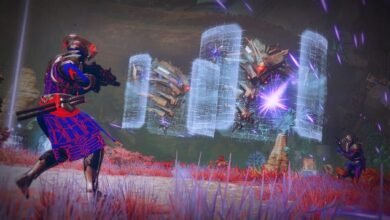Shiren the Wanderer: The Mystery Dungeon Of Serpentcoil Island Review: a traditional roguelite heavy on charm but light on agency

I’m quite smitten by the Nintendo DS stylings and traditional roguelike charms of Shiren the Wanderer: The Mystery Dungeon Of Serpentcoil Island, but I’m having real trouble summoning up the motivation to repeatedly grind through its opening levels to get to the interesting stuff. Early stages soon lose any real sense of surprise, and later ones can feel low on real agency. I want a new roguelike run to feel vital and verdant; heady with grand plans and plan-shattering twists. But by having randomness influence each run so significantly, Mystery Dungeon feels fickle instead of emergent – less than the sum of some incredibly novel and creative parts.
One of these parts is a talking ferret named Koppa, bless him. He’ll be doing the chatting for your character, Shiren, who opts to stay silent in a way that might be practised stoicism but feels mostly like constant bewilderment. At the game’s start, the adventuring duo find themselves deep in the titular dungeon, get thwomped, wake up in a nearby village, and vow to return to the mountain to seek some valuable treasure in the belly of a giant monster.
It’s a straightforward hook, but Mystery Dungeon has such lovely, warm JRPG vibes – all friendly colours and lush, stirring instrumentals – that it’s an easy world to get sucked in by. The story progresses in vignettes after failing a few runs or discovering new locations on your journey up the mountain, and you’ll meet new characters and factions, or sometimes unlock new paths. A normal town might turn out to have a surprising, stabby secret, and a usually sleepy beach in your starting village might host an uninvited guest one morning. Story scenes aren’t so common that you’ll see them every run, and so they’re a welcome break when they do pop up.

Mostly, though, you’ll be braving that mountain, one tile at a time. Each step or action you take counts as one turn, during which any monsters about will also take theirs. The goal on each stage is to locate the exit to the next level, though you’ll want to explore thoroughly to mop up loot and experience. Shiren heals one HP for each tile, but also drains a hunger meter. If this depletes, you’ll lose health, so you’ll want to stay stocked up with onigiri (rice balls). Shiren’s HP increases when they level up, but you can also eat healing herbs on full HP for a few more points. Your hunger meter doesn’t expand like this, but you can grow it by eating onigiri when you’re already full.
That’s one interesting consideration, straight off: do you save this stuff for when you’re desperate, or try to buff up Shiren early? Onigiri can rot if you try to hoard it, too, and Mystery Dungeon is also a game of novel emergent reactions. If you’re hit by a fireball, any onigiri you’re holding will grill, boosting its effects. How can you plan for this? Well, you can’t. Like basically everything interesting here, it just happens sometimes. If you’re thinking “that might be a problem, actually”, well…
At its most basic, combat involves trading blows with enemies turn by turn by inputting attack commands. But really, everything interesting or notable about combat encounters here stems from your inventory. Through exploring and killing monsters, you’ll amass a bag of scrolls, staffs, pots, and other consumables. A shot from a paralysing staff might leave a rotund cat unable to act for several turns. Or better yet, use it on the speedily hopping frog that steals your gold if it gets too close. Some dragonbreath grass will have Shiren breathe fire – though you might want to save those for physical-resistant spirits later. A bladewind scroll will clear a room in seconds, but is better tucked away for treasure rooms stuffed with enemies. There are more esoteric effects, too. Position switching. Confusion. An empathy spell that returns damage to sender. Learning how to counter an extensive bestiary remains a highlight, even if there’s little you can do to actually prepare.

Again: these are all random pick-ups. You can save and plan, and you’ve usually got at least a few things that can get you out of a bind, but there just isn’t much tactical satisfaction to getting lucky with drops, using them in obvious situations, then popping along on your merry way until you get stuck in a bind where you’re too depleted of good stuff to handle it. Emergent gameplay is great. It’s better than great. It’s one of gaming’s greatest joys. But it needs to be framed by agency, planning and decision making. There’s certainly some of that here, but I think the best way I can put it is that all this novelty can’t keep pace with the rate of progress. When you’re making discoveries, it’s incredibly absorbing. When you’re putting those discoveries into effect for the fifteenth time, it feels like a rote grind. It all means I’m not excited for another run, I’m just crossing my fingers until the game decides to cough up some pity treasure.
Aside from monsters, dungeon floors also hide traps and secrets. Place a wrong foot during combat, and you might hit a tile that strips your equipment, forcing you to spend two precious turns to grab your sword and shield again. Or, you might just get bonked halfway across the floor by a giant spring. Shopkeepers and blacksmiths are rare commodities in the occasional village between floors, but you’ll sometimes find a shop in a dungeon. I am 99% sure the shopkeeper will attack you if you don’t pay, but I’ve never been brave enough to try. There are also hidden walls, water you can dispel with a certain scroll for extra loot, and companions – one of which will let you send back a single item to a warehouse for your next run. How this usually works is I’ll send back my second best sword and find a much better one on the second floor.

It doesn’t help that I’m playing an early copy, of course, so I’m not getting the full experience of one of the more interesting things Mystery Dungeon does: rescues. You can request three rescues per run. This can be online – see above. Or, you can rescue yourself by progressing to the spot when you died. Why would you do this when it’s as time-consuming as a new run, and the version of you that died obviously wasn’t having a fruitful run or they’d still be alive? Honest question. I’m actually hoping I missed some revelatory feature that’ll let me enjoy my time with the ferret more.
More so than other games, my experience with Mystery Dungeon does feel like a case of the reviewer’s curse; the dreaded roguelike embargo. Played one run at a time as a cosy evening ritual, and the luster is going to stay on a lot longer. Still, that sense of fickleness – of having little agency how your runs turn out in the face of random drops – does feel like it’s baked in. Perhaps that’s the sticking point for me, having to deal with untameable chaos lurking underneath such inviting presentation. Perhaps I should let go and allow the winds of fate to carry me. It’s just not easy when they keep knocking me right back to the bottom of a mountain, and making me trust them again if I want to get back up.





